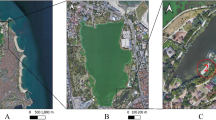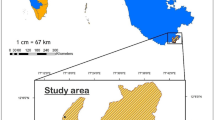Abstract
Inter-specific killing is common among carnivore species and is likely to be a major driver of their spatial ecology and habitat selection. Here, we test how selection of, attendance at, and proximity to dens by spotted hyaenas may be influenced by the risk of predation by lions. We studied 57 dens in the semi-arid savanna of Hwange National Park, Zimbabwe. Hyaenas did not appear to avoid denning in lion home ranges or their cores, but den selection correlated with environmental proxies of predation risk. Hyaenas preferred dens far from waterholes, which were intensively used by lions, and with numerous entrances presumably providing many escape options for cubs. Den attendance did not appear to be influenced by proxies of predation risk. However, as the risk of predation risk by lions (frequency and proximity of their presence in the vicinity of a den) increased during a given week, the likelihood of a hyaena visiting that den during this same week decreased (regardless of its current state, used or unused). This effect seemed to be stronger when lions were closer to the den. In addition, hyaenas appeared to adjust their patterns of den attendance according to recent (up to a month) lion presence in the vicinity of the den. They avoided using dens in a given week as the presence of lions during the preceding weeks increased. Hyaenas appeared to select their dens based on proxies of predation risk but may have also selected them depending on their knowledge of lion presence (current or past) in the area. Hyaena denning behaviour is therefore very dynamic and appears to be driven, at least in part, by the presence of their main competitor.
Similar content being viewed by others
References
Arjo, W.M., Bennett, T.J., Kozlowski, A.J., 2003. Characteristics of current and historical kit fox (Vulpes macrotis) dens in the Great Basin Desert, Can. J. Zool. 81, 96–102.
Boydston, E.E., Kapheim, K., Holekamp, K.E., 2006. Patterns of den occupation by the spotted hyaena (Crocuta crocuta), Afr. J. Ecol. 44, 77–86.
Broekhuis, F., Cozzi, G., Valeix, M., McNutt, J.W., Macdonald, D.W., 2013. Risk avoidance in sympatric large carnivores: reactive or predictive? J, Appl. Ecol. 82, 1098–1105.
Burnham, K., Anderson, D., 2002. Model Selection and Multimodal Interference: A Practical Information-Theoretic Approach, 2nd ed. Springer, New York, USA.
Carter, A., Wilson, B.P., Luck, G.W., 2011. Ecology of the red fox (Vulpes vulpes) in an agricultural landscape, 1. Den-site selection. Aust. Mammal. 34, 145–154.
Cooper, S.M., 1993. Denning behaviour of spotted hyaenas (Crocuta crocuta) in Botswana, Afr. J. Ecol. 31, 178–180.
Donadio, E., Buskirk, S.W., 2006. Diet, morphology, and interspecific killing in car-nivora, Am. Nat. 167, 524–536.
East, M.L., Hofer, H., Turk, A., 1989. Functions of birth dens in spotted hyaenas (Crocuta crocuta).J, Zool. 219, 690–697.
Fortin, D., Beyer, H.L., Boyce, M.S., Smith, D.W., Duchesne, T., Mao, J.S., 2005. Wolves influence elk movements: behavior shapes a trophic cascade in Yellowstone National Park, Ecology 86, 1320–1330.
Fuller, T., Keith, L, 1981. Non-overlapping ranges of coyotes and wolves in northeastern Alberta, J. Mammal. 62, 403–405.
Hemson, G., Johnson, P., South, A., Kenward, R., Ripley, R., Macdonald, D.W., 2005. Are kernels the mustard? Data from global positioning system (GPS) collars suggests problems for kernel home-range analyses with least-squares cross-validation, J. Appl. Ecol. 74, 455–463.
Henner, CM., Chamberlain, M.J., Leopold, B.D., Burger, J., Wes, L., 2004. A multi-resolution assessment or raccoon den selection, J. Wildl. Manag. 68, 179–187.
Hernández, L., Laundré,J.W., 2005. Foraging inthe ‘landscape of fear’ and its implications for habitat use and diet quality of elk Cervus elaphus and bison Bison bison, Wildl. Biol. 11, 215–220.
Hofer, H., East, M.L., 1993. The commuting system of Serengeti spotted hyaenas: how a predator copes with migratory prey, III. Attendance and maternal care. Anim. Behav. 46, 575–589.
Kamler, J.F., Stenkewitz, U., Klare, U.Jacobsen, N.F., Macdonald, D.W., 2012. Resource partitioning among cape foxes, bat-eared foxes, and black-backed jackals in South Africa, J. Wildl. Manag. 76, 1241–1253.
Kaneko, Y., Newman, C, Buesching, CD., Macdonald, D.W., 2010. Variations in Badger (Meles meles) sett microclimate: differential cub survival between main and subsidiary setts, with implications for artificial sett construction, Int. J. Ecol. 2010, 1–10.
Kolowski, J.M., Katan, D., Theis, K., Holekamp, K.E., 2007. Daily patterns of activity inthe spotted hyena.J, Mammal. 88, 1017–1028.
Kruuk, H., 1972. The Spotted Hyena: A Study of Predation and Social Behavior. University of Chicago Press, Chicago.
Laurenson, M., Wielebnowski, N., Caro, T.M., 1995. Extrinsic factors and juvenile mortality in cheetahs, Conserv. Biol. 9, 1329–1331.
Loveridge, A.J., Searle, A., Murindagomo, F., Macdonald, D.W., 2007. The impact of sport-hunting on the population dynamics of an African lion population in a protected area, Biol. Conserv. 134, 548–558.
Loveridge, A.J., Valeix, M., Davidson, Z., Murindagomo, F., Fritz, H., Macdonald, D.W., 2009. Changes in home range size of African lions in relation to pride size and prey biomass in a semi-arid savanna, Ecography 32, 953–962.
Loveridge, A.J., Hemson, G., Davidson, Z., Macdonald, D.W., 2010. African lions on the edge: reserve boundaries as ‘attractive sinks’. In: Macdonald, D.W., Loveridge, A.J. (Eds.), Biology and Conservation of Wild Felids. Oxford University Press, Oxford, pp. 283–304.
Macdonald, D.W., Newman, C, Dean, J., Buesching, CD., 2004. The distribution of Eurasian badger, Meles meles, setts in a high-density area: field observations contradict the sett dispersion hypothesis, Oikos 106, 295–307.
Mills, M.G.L., 1990. Kalahari hyaenas: Comparative Behavioural Ecology of Two Species. The Blackburn Press, Caldwell, NJ.
Mills, M.G.L., Biggs, H.C, 1993. Prey apportionment and related ecological relationships between large carnivores in Kruger National Park, Symp. Zool. Soc. Lond. 65, 253–268.
Mills, M.G.L., Mills, M.E.J., 2013. Cheetah cub survival revisited: a re-evaluation of the role of predation, especially by lions, and implications for conservation, J. Zool. 292, 136–141.
Moehrenschlager, A., List, R., Macdonald, D.W., 2007. Escaping intraguild predation: Mexican kit foxes survive while coyotes and golden eagles kill Canadian swift foxes, J. Mammal. 88, 1029–1039.
Norris, D.R., Theberge, M.T., Theberge, J.B., 2002. Forest composition around wolf (Canis lupus) dens in eastern Algonquin Provincial Park, Ontario, Can. J. Zool. 80, 866–872.
Palomares, F., Caro, T.M., 1999. Interspecific killing among mammalian carnivores, Am. Nat. 153, 492–508.
Périquet, S., 2014. Sharing the Top: How do Spotted Hyaenas Cope with Lions? Apex Predator Coexistence in a Wooded Savanna. Université Claude Bernard Lyon 1, Lyon.
Polis, G.A., Myers, C.A., Holt, R.D., 1989. The ecology and evolution of intraguild predation: potential competitors that eat each other, Annu. Rev. Ecol. Syst. 20, 297–330.
R Core Team, 2014. R: A Language and Environment for Statistical Computing. R Foundation for Statistical Computing, Vienna, Austria.
Revilla, E., Palomares, F., Fernández, N., 2001. Characteristics, location and selection of diurnal resting dens by Eurasian badgers (Meles meles) in a low density area, J. Zool. 255, 291–299.
Richards, S.A., Whittingham, M.J., Stephens, PA, 2011. Model selection and model averaging in behavioural ecology: the utility of the IT-AIC framework, Behav. Ecol. Sociobiol. 65, 77–89.
Rogers, CM., 1993. A woody vegetation survey of Hwange National Park. Department of National Parks and Wildlife Management, Harare, Zimbabwe.
Tannerfeldt, M., Elmhagen, B., Angerbjörn, A., 2002. Exclusion by interference competition? The relationship between red and arctic foxes, Oecologia 132, 213–220.
Theuerkauf, J., Rouys, S.,Jędrzejewski, W., 2003. Selection of den, rendezvous, and resting sites by wolves in the Bialowieza Forest, Poland, Can. J. Zool. 81, 163–167.
Valeix, M., Fritz, H., Loveridge, A.J., Davidson, Z., 2009a. Does the risk of encountering lions influence African herbivore behaviour at waterholes? Behav. Ecol. Sociobiol. 63, 1483–1494.
Valeix, M., Loveridge, A.J., Chamaillé-Jammes, S., Davidson, Z., Murindagomo, F., Fritz, H., Macdonald, D.W., 2009b. Behavioral adjustments of African herbivores to predation risk by lions: spatiotemporal variations influence habitat use. Ecology 90, 23–30.
van der Meer, E., Mpofu, J., Rasmussen, G.S.A., Fritz, H., 2013. Characteristics of African wild dog natal dens selected under different interspecific predation pressures, Mamm. Biol. 78, 336–343.
Watts, H.E., Holekamp, K.E., 2009. Ecological determinants of survival and reproduction inthe spotted hyena.J, Mammal. 90, 461–471.
Way, J.G., Auger, P.J., Ortega, I.M., 2001. Eastern coyote denning behavior in an anthropogenic environment, Northeast Wildl. 56, 18–30.
Author information
Authors and Affiliations
Corresponding author
Rights and permissions
About this article
Cite this article
Périquet, S., Mapendere, C., Revilla, E. et al. A potential role for interference competition with lions in den selection and attendance by spotted hyaenas. Mamm Biol 81, 227–234 (2016). https://doi.org/10.1016/j.mambio.2015.10.005
Received:
Accepted:
Published:
Issue Date:
DOI: https://doi.org/10.1016/j.mambio.2015.10.005




